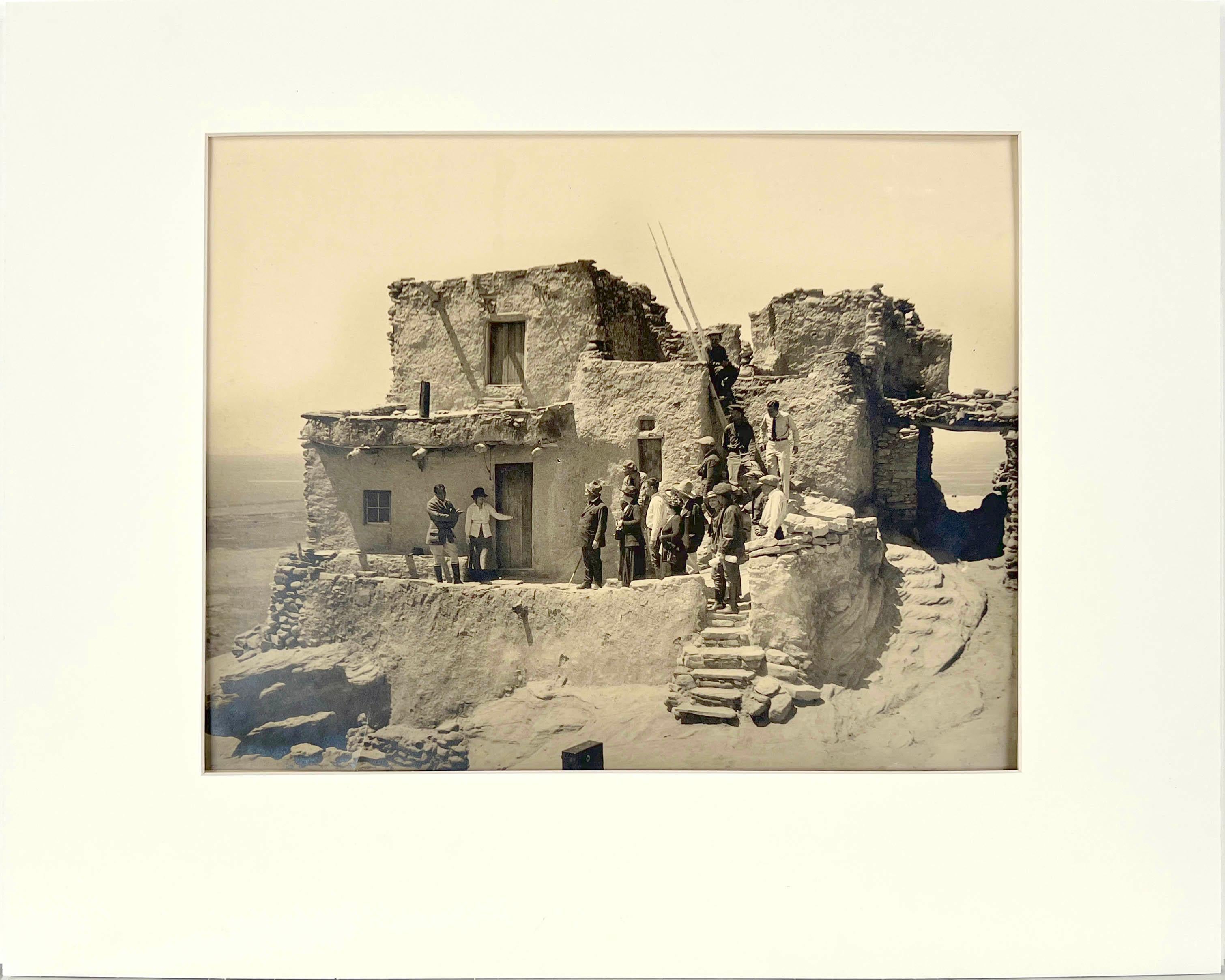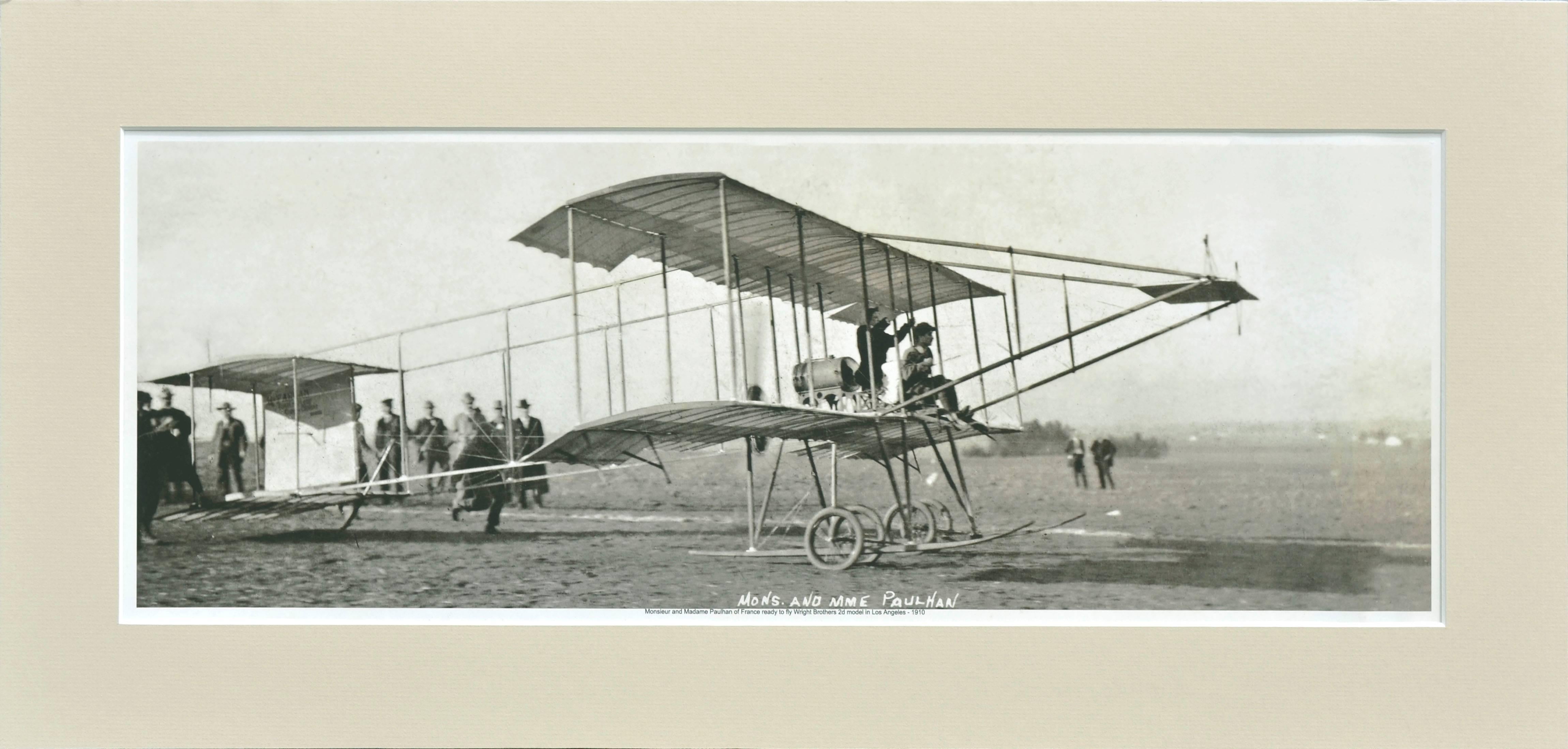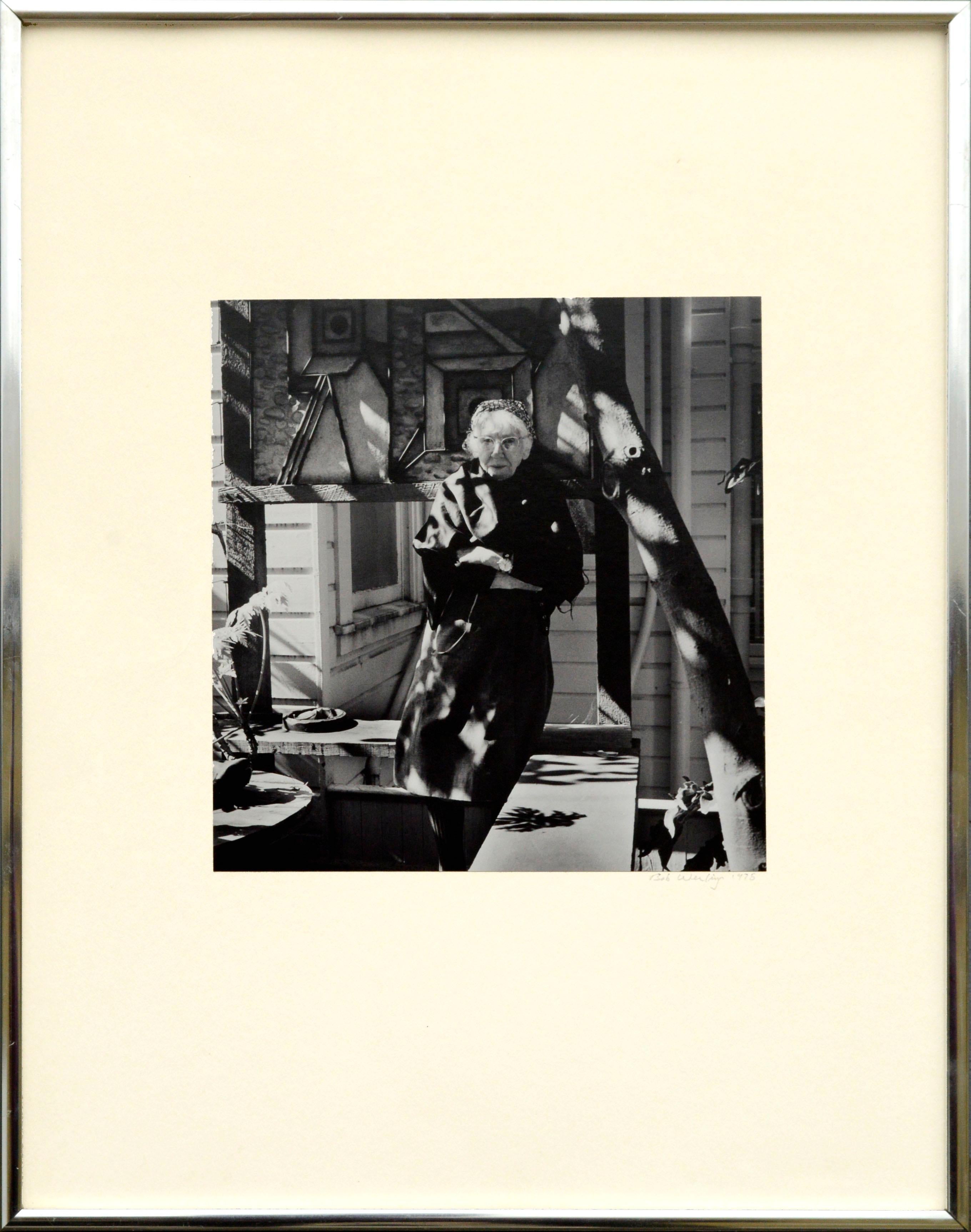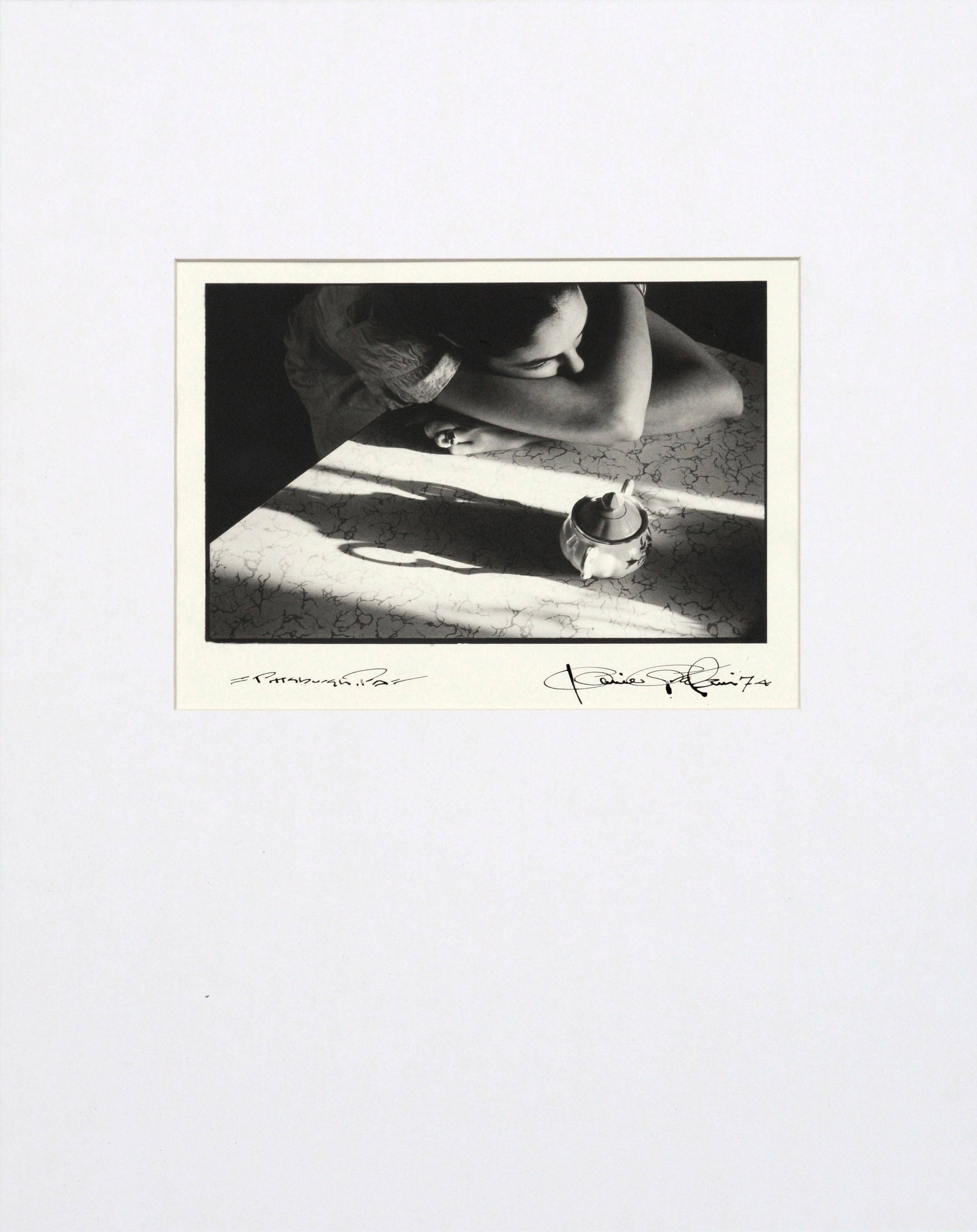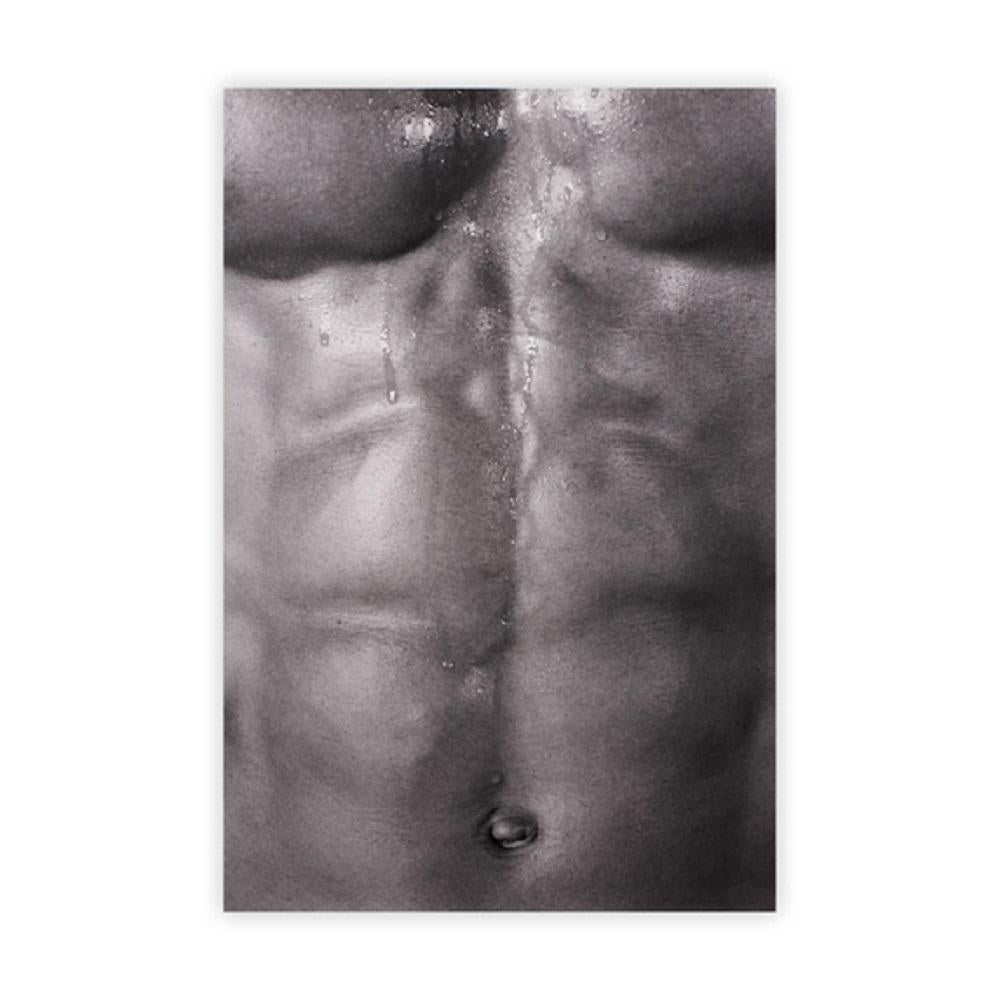Betty HahnArrival or Departure Photographic Series (After Hitchcock) 1987
1987
About the Item
- Creator:Betty Hahn (1940)
- Creation Year:1987
- Dimensions:Height: 25 in (63.5 cm)Width: 18 in (45.72 cm)Depth: 2 in (5.08 cm)
- Medium:
- Movement & Style:
- Period:
- Condition:Excellent photograph condition, some bowing to one or two of the foam cores and edge impressions to print surface at frame margins.
- Gallery Location:Soquel, CA
- Reference Number:
Betty Hahn
Betty Hahn was born Elizabeth Jean Okon in 1940, in Chicago, Illinois. In 1967, Betty Hahn moved to Rochester to pursue a job at Kodak or Xerox. While in Rochester, she participated in Nathan Lyons's Visual Studies Workshop from 1967–68. Lyons lectured on Vernacular and Snapshot photography to workshop students, reinforcing Betty's interest in this "folk" tradition. During her time at the VSW, she met Tom Barrow, Roger Mertin and Alice Wells, and reconnected with Robert Fichter. She was encouraged by how their work was challenging the rules of what was common in fine-print photography. At age 10, her aunt Marcella Brown gave Betty her first camera, a Brownie #2. At this same time, the Okon family moved to Indianapolis, Indiana. After graduating from Scecina Memorial Catholic High School in Indianapolis, she entered Indiana University in Bloomington, Indiana. Hahn earned a four-year scholarship and studied fine arts. While she was experimenting with photographic image-making, her initial artistic experiences involved painting and drawing. Hahn did not take photography seriously as a medium for her artistic expression during her undergraduate work.
At age 23, Hahn graduated with a bachelor of arts degree and continued at Indiana University for graduate studies in the department of photography. At the suggestion of Henry Holmes Smith, she started experimenting with the gum bichromate process. Smith convinced Hahn that photography was serious, potent stuff, and she eventually settled into a comfortable but exciting dialogue with photography, which would characterize her career. Working under Smith, Hahn met Robert Fichter, who became the subject of some of her early photographic projects. In 1966, after graduating with a master of fine arts degree from Indiana University, she moved to Ithaca, New York. She was hired at Cornell University to make slides for the Art History Department slide library. After a year at Cornell, she moved to Rochester. After spending some time at VSW, she began teaching photography and design to deaf students at the National Technical Institute for the Deaf. After a year, Hahn transferred to the School of Photographic Arts and Sciences at Rochester Institute of Technology, where she taught until 1975. She met Lee Witkin at a reception at the George Eastman House in Rochester, New York, in 1972.
Hahn’s first one-person show, "Betty Hahn," opened in New York City at the Witkin Gallery in 1973. In 1974, she received a grant from the National Endowment for the Arts to be a visiting artist at Franconia College, New Hampshire, to continue projects in non-silver processes and mixed media. At the age of 36, Hahn was hired as a visiting professor to teach photography at the University of New Mexico in Albuquerque. In 1978 and 1983, she received grants from the National Endowment for the Arts for ongoing projects. During the spring semester in 1986, she became a full-time professor of photography. She taught there until retirement in 1997. Among the museum collections that contain Hahn's work is the Art Institute of Chicago; the Museum of Modern Art, New York; the National Gallery, Ottawa: and the San Francisco Museum of Modern Art.
(Biography provided by Robert Azensky Fine Art)- ShippingRetrieving quote...Ships From: Soquel, CA
- Return PolicyA return for this item may be initiated within 14 days of delivery.
- Mary Pickford Douglas Fairbanks at Walpi First Mesa Hopi Village 1920 PhotographLocated in Soquel, CAMary Pickford and Douglas Fairbanks at Walpi First Mesa Hopi Village 1920 Photograph Original Sepia toned Silver gelatin photographic print by Charles Roshe (British, 1885-1974). Provenance: Mary Pickford, Elizabeth (Bess) Huggins. Image 10.75"H x 13.75"W He was Mary Pickford's favorite cinematographer and a personal friend, shooting all of the films in which she starred from 1918 to 1927, before they had a falling out during production of Coquette (1929). He was the first cinematographer to receive an Academy Award, along with Karl Struss, for Sunrise: A Song of Two Humans (1927), and won again for The Yearling (1946), with Leonard Smith and Arthur Arling. He was also nominated four times. Walpi, pueblo (village), Navajo county, northeastern Arizona, U.S., on the edge of a high mesa in the Hopi Indian Reservation. It comprises a group of angular stone houses of two to three stories crowded on a narrow tip of the steep-walled mesa at an elevation of 6,225 feet (1,897 metres). The original pueblo (founded c. 1700) was on a lower part of the mesa, but following the Pueblo Rebellion, the inhabitants moved to the top as a defensive measure against Spanish retaliation. Walpi is known for an antelope ceremony and for snake dances, held during odd years in August and generally closed to non-Hopi spectators. Shitchumovi (Sichomivi) pueblo is adjacent and Hano is nearby. Pickford was the first Canadian to win an Oscar. She was also the second to win best actress and the first for a role in a film with sound. She was one of the founding members of the Academy of Motion Picture Arts and Sciences. In 1919 Pickford took the lead in organizing the United Artists Corporation with Griffith, Charlie Chaplin, and Douglas Fairbanks. In 1920, after the dissolution of her first marriage (1911–19) to actor Owen Moore, she married Fairbanks (divorced 1936). Pickford’s popularity continued unabated in Pollyanna (1920), Little Lord...Category
1920s Realist Black and White Photography
MaterialsPhotographic Paper, Silver Gelatin
- Home of Colonel William H. Terrill Roanoke Virginia Original PhotographLocated in Soquel, CAHome of Colonel William H. Terrill Roanoke Virginia Original Photograph Home of the Colonel William Terrill (CSA) Roanoke Virginia, original period s...Category
1870s Realist Black and White Photography
MaterialsPhotographic Paper, Ink, Silver Gelatin
- Monsieur - Madame Paulhan Fly a Farman Airship 1910 Los Angeles Int. Air ShowBy Roy ChristianLocated in Soquel, CAReprint of a vintage photograph titled "Monsieur (Louis) and Madame Paulhan of France ready to fly a Farman model lll in Los Angeles - 1910 from an original photograph by an unknown ...Category
Early 2000s Realist Black and White Photography
MaterialsPhotographic Paper, Silver Gelatin
- Portrait of Imogen Cunningham - Black & White PhotographBy Robert WerlingLocated in Soquel, CAA stunning black and white photographic portrait of Imogen Cunningham (1883-1976) by California photographer, Robert Werling (b. 1946). Signed and dated by the artist on the mat, low...Category
1970s Realist Black and White Photography
MaterialsSilver Gelatin, Photographic Paper
- Portrait of a Woman with Teapot, 1970s Pittsburgh Black & White PhotographLocated in Soquel, CACompelling 1970s black and white photograph of a contemplative woman leaning on a table into her crossed arms, beside a small teapot that casts a long sha...Category
1970s Realist Black and White Photography
MaterialsPhotographic Paper, Silver Gelatin
- Henry Miller And Eve Miller On Partington Ridge - 1954 Original PhotographLocated in Soquel, CA"Henry And Eve Miller On Partington Ridge" - 1954 Original Photograph 1954 original black and white silver gelatin photograph of Henry and Eve Miller at their house on Partington Ri...Category
1950s Photorealist Black and White Photography
MaterialsInk, Photographic Paper, Silver Gelatin
- Isabel Muñoz Spanish Artist Original Hand Signed photographyLocated in Miami, FL"Isabel Muñoz (Spain, 1951) 'Serie Capoeira', 2005 photography on paper 49.3 x 41 in. (125 x 104 cm.) Edition of 35 ID: MUÑ1671-001-035 Hand-signed by aut...Category
Early 2000s Realist Figurative Photography
MaterialsPhotographic Paper
- Martha Graham & Erick Hawkins at Bennington CollegeLocated in Wilton Manors, FLMartha Graham and Erick Hawkins at Bennington College, 1940. Hand-colored period archival print. Unsigned. Some very minor soiling where matting window met print surface as is eviden...Category
1940s Realist Black and White Photography
MaterialsPhotographic Paper
- Photography - Boy on the donkey at mountains. 1979. 30x40 cmLocated in Riga, LVPhotography by Dmitry Zyubritsky Boy on the donkey at mountains. 1979. Size 30x40 cmCategory
1970s Realist Figurative Photography
MaterialsPhotographic Paper
- Spanish Artist signed limited edition numbered original art photography balletLocated in Miami, FLIsabel Muñoz (Spain, 1951) 'Serie Ballet Cuba', 2005 photography on paper 39.4 x 39.4 in. (100 x 100 cm.) Edition of 35 Unframed ID: MUÑ1671-002-035 Hand-...Category
Early 2000s Realist Figurative Photography
MaterialsPhotographic Paper
- Vintage Silver Gelatin Signed Print Old Jew in Jerusalem Pious CraftsmanLocated in Surfside, FLRare vintage signed and dated silver gelatin black & white framed photograph. This photo is signed but I cannot make out the signature. It is from the aftermath of the six day war. Leonard Freed, Micha Bar Am, Henri Cartier-Bresson, David Rubinger...Category
1960s Realist Black and White Photography
MaterialsSilver Gelatin
- Dans le Quartier Hongrois de Mea Shearim, Jerusalem Vintage Silver Gelatin PrintBy Frederic BrennerLocated in Surfside, FLMeah Shearim photograph of Torah scholars. Rabbis in Jerusalem. Photo of Hungarian quarter. Frédéric Brenner (born 1959) is a French photographer known for his documentation of Jewish communities around the world. His work has been exhibited internationally, among others, at the International Center of Photography in New York, the Musée de l'Élysée in Lausanne, Rencontres d'Arles in Arles, the Brooklyn Museum in New York, and the Joods Historisch Museum in Amsterdam. Brenner was born in Paris and grew up in France. In 1981, Brenner received a B.A. in French Literature and Social Anthropology from the Paris-Sorbonne University. He went on to study at the École des hautes études en sciences sociales and received a M.A. in Social Anthropology, also awarded by the Sorbonne. Brenner is the recipient of the Niépce Prize and his book Diaspora: Homelands in Exile won the 2004 Visual Arts Award from the Jewish Book Council. At age 19, Brenner began photographing Orthodox Jews in the Mea Shearim neighborhood of Jerusalem. Initially, he believed this was "authentic Judaism," but his approach quickly evolved into an exploration of the multiplicities of dissonant identities. In 1981, Brenner began photographing Jewish communities around the world, exploring what it means to live and survive with a portable identity and how Jews adopted the traditions and manners of their home countries and yet remained part of the Jewish people. He spent 25 years chronicling the diaspora of the Jews across the world from Rome to New York, India to Yemen, Morocco to Ethiopia, Sarajevo to Samarkand. Brenner has published five books and directed three films. His work has been shown in museums and galleries around the world. He has been represented by Howard Greenberg Gallery in New York since 1990. Brenner’s opus Diaspora: Homelands in Exile was published as a two-volume set of photographs and texts by HarperCollins in 2003 and appeared in four foreign editions. Diaspora was also a major exhibition, which opened in New York at the Brooklyn Museum in 2003 and traveled to nine other cities in America, Europe and Mexico. In reviewing the book, The New Yorker wrote: “Brenner's work—elegiac, celebratory, irreverent—transcends portraiture, representing instead a prolonged, open-ended inquiry into the nature of identity and heritage.” NPR's Robert Siegel has described Brenner's work as "a celebration of the diversity and complexity of diaspora." In 2006, Brenner founded This Place, a collective photography project aimed at recontextualizing Israel from multiple perspectives. The photographers working on this project include Wendy Ewald, Martin Kollar, Josef Koudelka, Jungjin Lee...Category
1970s Realist Black and White Photography
MaterialsSilver Gelatin
